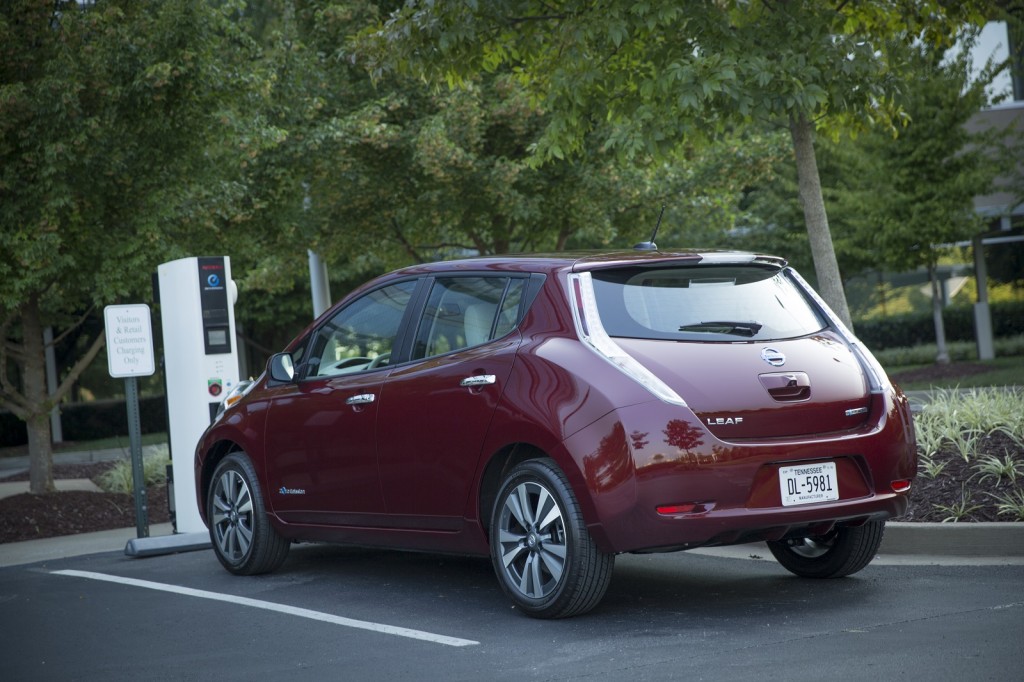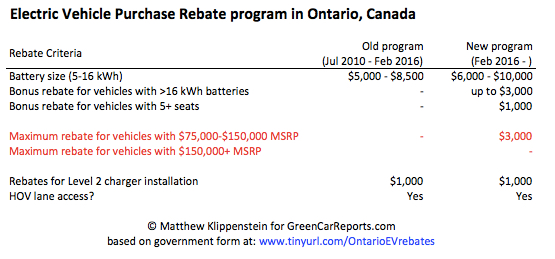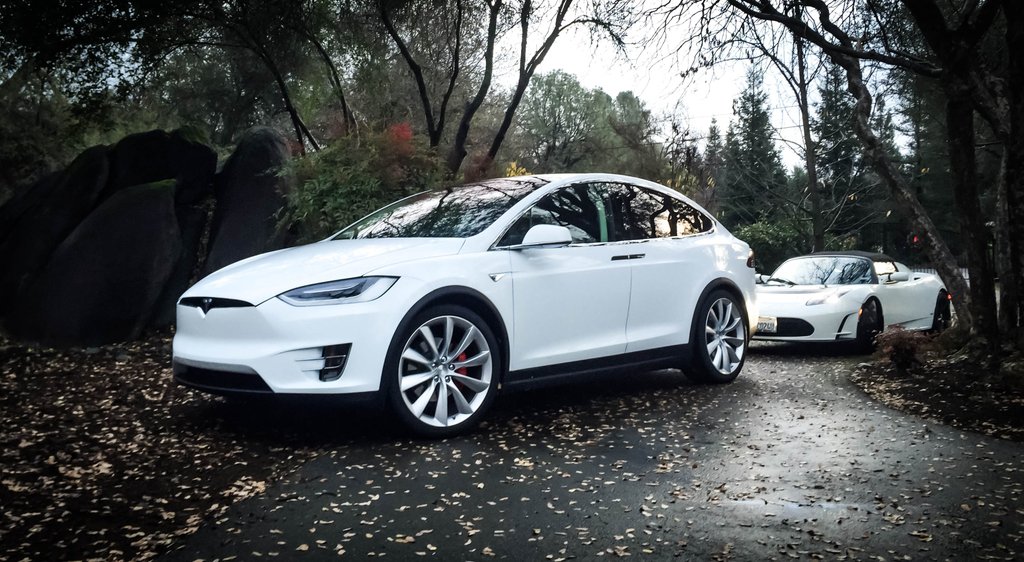
2016 Nissan Leaf
As U.S. electric-vehicle advocates are well aware, a handful of states have reduced or killed incentives for plug-in vehicles over the past year, adding some headwinds to sales.
Earlier this month, the Canadian province of Ontario took the opposite approach, expanding its plug-in electric vehicle incentive program. It's a welcome tailwind.
The new initiative isn't entirely surprising, as the province has burnished its green credentials in recent years, notably phasing out its use of coal.
DON'T MISS: When Electric-Car Incentives Return: British Columbia Case Study
Premier Kathleen Wynne was also the Minister of Transportation when the province's first incentive program was introduced six years ago, so she may have a deeper appreciation of the history than many of her provincial or state peers.
Ontarians previously received a purchase rebate ranging from $5,000 to $8,500 based on the battery size of their plug-in electric car.

Electric Vehicle Purchase Rebate program, Ontario, Canada
The now-discontinued Toyota Prius Plug-In Hybrid's 4.4-kilowatt-hour battery earned the minimum rebate, while vehicles with batteries of 16 kWh or more earned the maximum.
The new rebates have been set at $6,000 to $10,000 for vehicles with 5- to 16-kWh batteries, respectively--and cars with batteries larger than 16 kWh qualify for a further $3,000 rebate.
Autos with five or more seats qualify for an additional rebate of $1,000, perhaps in recognition that four-seaters such as the BMW i3 and first-generation Chevy Volt don't offer quite the same utility.
Lastly, in a nod to the tenuous optics of offering rebates to luxury-car buyers, purchase rebates are capped at $3,000 for vehicles with a Manufacturer's Suggested Retail Price above $75,000--and do not apply to cars costing more than $150,000.

British Columbia reinstates its incentives for plug-in electric car purchase, February 2015
As a patient public servant told us:
"Our decision to cap incentives for vehicles with a MSRP of $75,000 reflects the trend toward more affordable [electric cars] coming to market – vehicles that will appeal to more and more Ontarians.
"However, EVs still carry a significant price premium when compared to an equivalent gasoline vehicle. Our modernized Electric Vehicle Incentive Program will help make these vehicles more affordable to the average family.
"We will continue to provide incentives for vehicles at the higher end of the range, but it is increasingly difficult to justify providing incentives to high-income earners for vehicles that may likely be purchased regardless of the incentive. That is the reason we are focusing the program's funds where it makes the most sense: on mid-range vehicles."
Tesla fans may be disappointed that the Model S and X will only qualify for $3,000 in provincial rebates.

2016 Tesla Model X with 2011 Tesla Roadster Sport, photographed by owner Bonnie Norman
But even if the company's Model 3 arrives late, it should qualify for a whopping $14,000 in incentives, because the program presently has no cap.
Quoting the same government representative:
"At this time, the program does not have a specific end date. However, we will be regularly reviewing the incentive program to ensure it is responsive to industry trends and emerging technologies."
Rebates will also be capped at 30 percent of manufacturer's MSRP, meaning that buyers won't be able to buy the Smart Electric Drive for half-price. (Smart ED buyers would otherwise receive $13,000 in rebates for a $26,990 vehicle.)
The government webpage listing rebates for qualifying plug-in electric vehicles can be found here.
![Ontario, Canada [map: Wikimedia Commons] Ontario, Canada [map: Wikimedia Commons]](https://images.hgmsites.net/lrg/ontario-canada-map-wikimedia-commons_100546565_l.jpg)
Ontario, Canada [map: Wikimedia Commons]
Next-best to ZEV?
Policy analysts and advocates are nearly unanimous in agreeing that a California-style Zero Emission Vehicle (ZEV) mandate is the best way to ramp up plug-in electric vehicle adoption at a rapid pace. If automakers are required to sell such vehicles, they'll do so, cross-subsidizing from the rest of their product lines.
ALSO SEE: Canadian Plug-in Electric Vehicle Study: 1 Percent To 30 Percent Is The Challenge
Of course, ZEV mandates are very, very difficult to implement politically--and California is something of a special case.
Wealthy and populous, the state is a big enough auto market that carmakers can't afford to simply stop selling cars there.
In addition, the earliest regulatory efforts by the California Air Resources Board were aimed at fighting smog, a visible pollutant and lung irritant which tended to galvanize voter support more than does carbon dioxide, the colorless, odorless greenhouse gas.

2016 Nissan Leaf
Ontario, meanwhile, depends on eight automotive assembly plants to underpin its manufacturing sector, meaning it can't afford to alienate carmakers, who could retaliate by moving to lower-cost jurisdictions like Mexico.
Strong plug-in electric vehicle incentives may well thus be the best incentive that could be hoped for in the province.
Part of an "all of the above" strategy
Critics will no doubt continue arguing that electric-vehicle rebates are an expensive way to cut greenhouse-gas emissions. Ontario's example shows that the argument can be both factually accurate and contextually flawed.

Tailpipe Emissions
It's true that plug-in purchase incentives are a costly way of reducing greenhouse gas emissions.
A $14,000 purchase rebate would equate to paying $175 to $350 per avoided ton of CO2 emissions, assuming the electric cars are powered by clean electricity and that they displace vehicles that produce 2 to 4 tons of carbon dioxide each year over two decades--or 40 to 80 tons in total.
But it's important to note that where such incentives are offered, they're generally a small part of an "all of the above" strategy for reducing greenhouse gas emissions.
And in those scenarios, there will necessarily be lower-cost and higher-cost actions. Choosing only the single lowest-cost action – assuming it will be the "magic bullet" – is invariably less effective.
Ontario is set to put a price on carbon, most likely matching the $15/ton rate of neighboring Quebec – which translates to about 3.5 cents per litre, or 13 cents per gallon. Though modest by Scandinavian standards, it's now politically feasible.
![Electric-car rally in Geiranger, Norway [Image: Norsk elbilforening via Flickr] Electric-car rally in Geiranger, Norway [Image: Norsk elbilforening via Flickr]](https://images.hgmsites.net/lrg/electric-car-rally-in-geiranger-norway-image-norsk-elbilforening-via-flickr_100530088_l.jpg)
Electric-car rally in Geiranger, Norway [Image: Norsk elbilforening via Flickr]
More significantly, the province managed to phase out its use of coal in 2014, through a combination of nuclear energy, natural gas, and efficiency measures.
A recent Institute for Research On Public Policy paper estimated that the phase-out cut emissions at the same rate as a $100-$130 per ton carbon tax. (Emissions dropped about 25 million tonnes per year.)
The province is also investing heavily in public transit, through its Moving Ontario Forward program:
- "Ontario has identified Regional Express Rail (RER) as a top priority for investment in the Greater Toronto and Hamilton Area (GTHA). This service will provide faster and more frequent service on all corridors of the GO Rail network with electrification of core segments of the network. Through the implementation of RER, the province will benefit from additional transportation options and GHG reductions from:
- - fleet transition (from diesel locomotives to electric locomotives and electrical multiple units);
- - mode shift (as new transit riders opt to use GO RER rather than drive); and
- - improved land use mix and increased density."
Finally, to use the old business phrase, Ontario is "eating its own dog food" by incorporating plug-in electric vehicles into its provincial fleet.

2011 Zero DS Electric Motorcycle Joins Met Police
As relayed by the government official:
"Plug-in Hybrid Electric Vehicles are currently incorporated into Ontario's passenger vehicle fleet and their future acquisition will be considered in accordance with the acquisition and replacement strategy utilized by the Ontario Public Service (OPS).
"The goal of this strategy is to ensure that the best overall return of investment is applied and that energy efficient vehicles are utilized."
Though Ontario's purchasing policy isn't as aggressive as Quebec's – where plug-in vehicles are to be purchased or leased whenever possible – it should provide modest incremental demand and introduce more municipal drivers to the joys of electric propulsion.
From an advocacy standpoint, the more butts in seats we see today, the more plug-ins there'll be on streets tomorrow!
[The author would like to express his appreciation to A.W. at the Ministry of Transportation of Ontario, and to Sean Hart and the Canada Nissan Leaf Owners Facebook group for their assistance.]
_______________________________________












